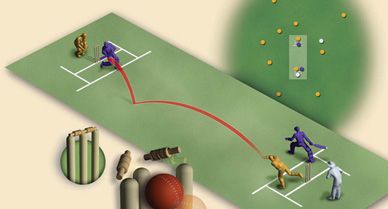Cricket for Dummies
It’s a lot like baseball. Except that it’s profoundly different
When I lived in Washington a few years back, my favorite spot in America was Section 336, high above home plate at the Baltimore Orioles' stadium, Camden Yards. My special delight was to take along our English visitors—all baseball virgins, all keen on cricket—and explain the American game by analogy with the English one. I never had a failure. They all grasped baseball, and they all relished it.
Notoriously, this process does not work in reverse. Thousands of Americans have gone to Lord's, cricket's London headquarters, and retreated in bewilderment. The most eloquent was Groucho Marx, who reputedly watched for an hour, and said: "This is great. When does it start?"
For sure, cricket seems inaccessible. But the superficial differences mask the essential truth: both cricket and baseball operate on the same principles. Someone hurling the ball—the pitcher in baseball, the bowler in cricket—is attempting to defeat an opponent wielding a bat to defend a target—the invisible strike zone or the visible wicket—and score runs.
The pitcher/bowler (using speed, swerve, spin or guile) is assisted by fielders while the batter's teammates await their turns. These fielders can remove the batter either by catching the ball or returning it to the batter's destination before he can get there. The batter's jackpot is hitting the ball in the air out of the field: a homer to you, a six to us. And the team that scores the most runs wins. Now, that wasn't so hard, was it?
Grasp the similarities, and you can start to understand the differences. In cricket, two bowlers and two batsmen operate in tandem. One bowler has six throws from one set of wickets; another has six goes at the other. The bowlers' primary objective is to hit the wickets, in which case the batsman is out. When the onfield captain (not a manager) is fed up with the bowlers, they remain in the game as fielders and may try again later. The batsmen, for their part, are not obligated to run when one of them hits the ball, but they score runs when they run from wicket to wicket without being put out. And they stay at bat until they are out.
This can sometimes mean all day, or even longer: a batsman's aim is to score a hundred or more runs. But cricket is elastic. Games comprise either one or two innings, and can last five full days or be as short as a few hours. And yes, the players normally stop for lunch and tea. But that means the fans also get to eat during the breaks, instead of missing the best bits while lining up for hot dogs and pizza.
Cricket has other virtues. Because the cricket bat is wider and the ball can be successfully hit through 360 degrees, there is an infinite variety of shots, ranging from the bludgeoning to the elegant. And because the ball is meant to bounce en route to the batter, each game takes its character from the turf underfoot: wet or dry, fast or slow, flat or bumpy.
Of course, hardly anyone watches for five days solid, except the umpires. But the game must have something going for it. For the five-day Test between England and Australia scheduled for Melbourne on December 26, all 95,000 tickets were sold out for each of the first three days more than six months in advance.
Matthew Engel is editor of Wisden Cricketers' Almanack, which has recorded every important game since 1864.



